DepthReading
In the footsteps of my dynastic forerunner
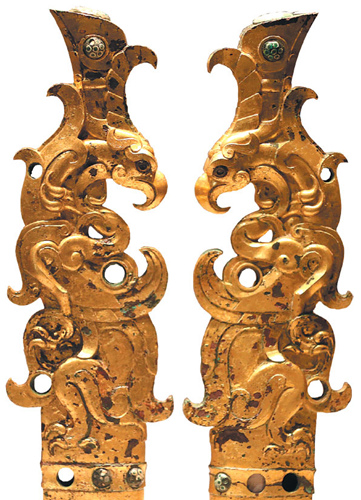 |
Gilt bronze finials in the shape of mythical beasts inlaid with glass. [Photo provided to China Daily] |
After toppling its adversary, a dynasty of 2,200 years ago paid due respect to the ways of its predecessor
Qin, whose first emperor united China for the first time, and Han, the dynasty believed to have laid the foundation for Chinese culture and civilization, had what today we might call a love-hate relationship.
Han (202 BC-AD 220) toppled Qin (221-206 BC), yet it adopted most of the rules and systems installed during its predecessor's time, in cultural, economic and political spheres. In many respects, Han was Qin's successor in the true sense of the word.
One telling example, says Tian Yaqi, of the Shaanxi Provincial Institute of Archaeology, involves Yongcheng, or the city of Yong, which served as capital of the kingdom of Qin between 677 BC and 383 BC, more than a century before the kingdom set itself on a course of constant expansion.
"On Qin's demise, the rulers of Han made Xi'an, by then known as Chang'an, 170 kilometers east of Yongcheng, the political center of their new regime," Tian says.
"Then, in a highly unusual gesture, they continued the Qin practice of using Yongcheng as the site of state-level worship, namely the offering of sacrifices to heaven.
"I say highly unusual because Chinese emperors believed their mandate came from heaven, calling themselves tianzi, the son of heaven. The fact that the early Han rulers, who still had the overthrow of the Qin fresh in mind, would cling to that same location to worship and solicit heaven's help is hard to believe."
Tian says the decision speaks a lot about the political wisdom and pragmatism of the Han rulers - their willingness to compromise if it meant a more speedy recovery of the war-torn society.
"Relocating the place of worship would have involved a huge amount of labor and cost. Judging by the evidence, the early rulers of Han did indeed learn a lesson from the demise of Qin."
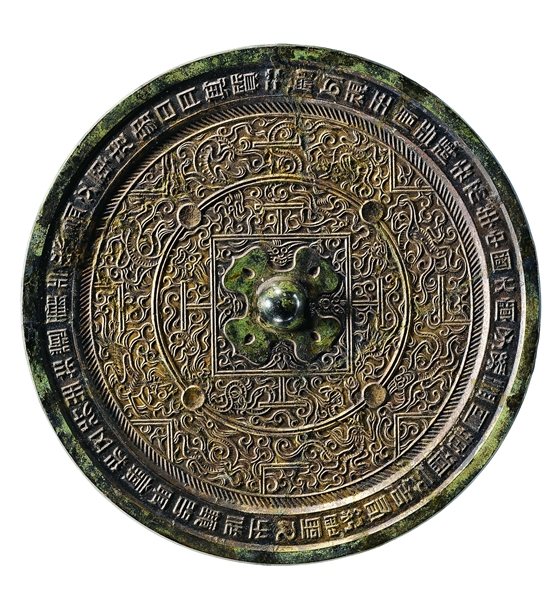 |
The gilt bronze mirror with circular inscriptions mentioning the term China. [Photo provided to China Daily] |
In 221 BC, Ying Zheng (259-210 BC), ruler of the Qin Kingdom, finally defeated all other kingdoms with which his ancestors had been at war for more than 400 years, off and on. Immediately, the strong man set out to dismantle all the hurdles that stood in the way of making his empire a cohesive, if not unanimous, whole. Measures taken included introducing a single currency, unifying weights and measures and simplifying and unifying Chinese characters.
Archaeological finds testifying to such efforts are now on display at the National Museum of China in Beijing, where a pottery measure of 2,000 milliliters is displayed alongside an iron weight with a bronze board whose inscription says that the weight was minted as "a standard for all".
Both items are part of an exhibition titled The Glory of Qin and Han. Although exhibits from the period of Han form the bulk of the show, it opens with a few Qin terra cotta warriors and a horse.
Qian Wei, of Art Exhibitions China, a State-owned cultural exchange organization that previously teamed up with the Metropolitan Museum of Art in New York for a grand exhibition showcasing the civilization of Qin and Han, says: "It's fair to say that the rupture caused by dynastic change between Qin and Han was more than mended by a policy of continuity. Together, the two periods shaped China."
Most exhibits from the Met exhibition are on show at the National Museum of China, and other precious antiques have been added.
Ying Zheng, whose gigantic army once swept across all of China, built roads and canals to facilitate transport. He also decreed that there should be a standard axle width for carriages and that all roads should be built accordingly. Before those standards were introduced, the driver of a Qin chariot would have had a hard time passing through the neighboring kingdom of Zhao, for example.
While continuing to travel on the Qin road, the Hans also searched for their own ones, some of which led them to worlds they had never known of. In about 138 BC Emperor Wudi, the fifth emperor of the Han Dynasty, sent a convoy of more than 100 members on a westward journey that held as much attraction as hazard.
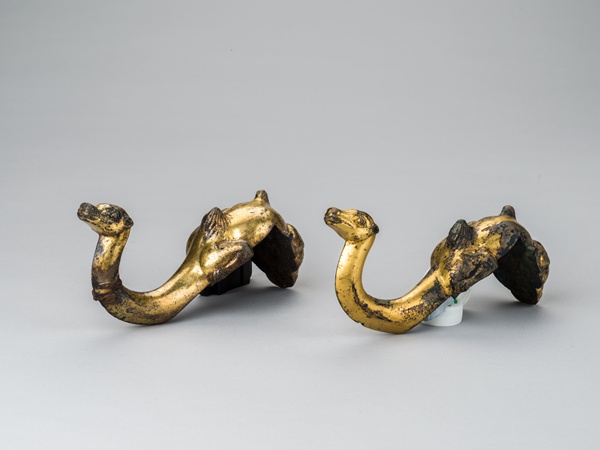 |
Gilt bronze crossbow holders. [Photo provided to China Daily] |
The envoy was led by Zhang Qian, a man credited today with opening China's terrestrial Silk Road, a route that connected ancient China with central and western Asia, including what is now Iraq. The Hans paid great attention to the safety of the trade route, so much so that they repaired and maintained the Great Wall - a meandering defensive structure first built by Ying Zheng - at great cost.
The opening-up of the Silk Road brought two-way influences that can be glimpsed in the exhibition. Gilt bronze mat weights are embedded with gemstones including agate and turquoise, stones that probably came from outside China, Central Asia for example. The Han people liked to place themselves in a kneeling position when they sat down on the mat, and the weights served to keep the mat from moving.
This trade route, known also as the Desert Silk Road because it traversed large tracts of deserted land in what is now Gansu province, was augmented by others. Among them was a maritime silk road just starting to form. "We have on display crystal beads unearthed in today's Hepu county in the Guangxi Zhuang autonomous region, on China's southern coast," Shan says.
"Crystal as a natural material is not native to Hepu, and archaeologists believe the beads, dating back to the Han era, must have been brought from the South and Southeast Asia by sea."
A prominent decorative feature of the Han Dynasty involves the use of animal motifs. These are mostly animals from the northern prairie - deer, horses, tigers and bears. In these depictions there is often an element of tension either between two kinds of animals, or between animal and human being.
"The kingdom of Qin sits in what is now Shaanxi province, abutting the Inner Mongolia autonomous region," Shan says. "The conquering of the kingdoms of Zhao and Yan, located to its east and northeast, about 222 BC meant that Qin now shared a more extensive border with the vast grassland to its north, land dominated by steppe culture. Over time this culture insinuated its way first into Qin the kingdom and then the empire. The seepage continued throughout the Han Dynasty."
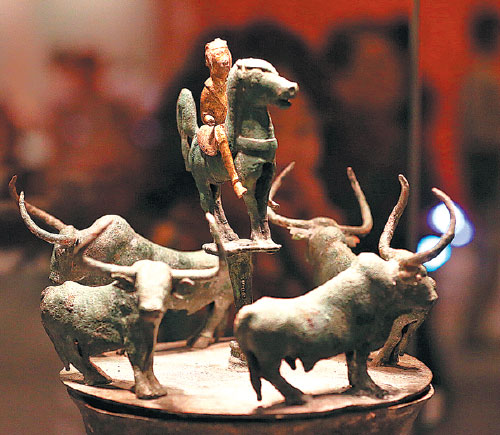 |
Bronze cowrie container with four bulls and a mounted rider. [Photo provided to China Daily] |
A magnificent example is the set of four gilt copper mat weights. Each features a bear and a tiger engaged in a tight tussle, so tight that they are almost inseparable from each other. The tiger's luscious fur pattern is evoked by swirling streaks of gold, further heightening the sense of movement that makes the weights memorable works of art.
For Qin, conquering went hand in hand with assimilation. Han, which continued to expand its territory, forged ahead in the same direction, with a vision and verve recalling the formative years of the Empire of Qin.
Tian says: "During the reign of Han, China never saw the kind of conquering war and bloodshed that took place in the previous era, but if you look at the chariot unearthed from the Han tombs - all those gold and gilt bronze ornaments for the vehicle and the horse, as well as those animal-shaped bronze crossbow holders that were part of the chariot - you would know that the heroism of those bygone times were looked upon with nostalgia.
"One gets the feeling that in the heart of this man from Han is his Qin predecessor, standing proudly on his chariot, hand on shaft, charging through boundless land, unstoppable, ready to take on all and embrace all."
The last item on display in the National Museum's exhibition is a bronze mirror from Han, its eye-bewildering pattern on the back in full display. The intricate design is rimmed by words that read: "This mirror is made in accordance with the laws of the ancient sage and the rules of heaven ... Examine your own countenance with it, to rid yourself of anything inauspicious, and pray for the stability of China."
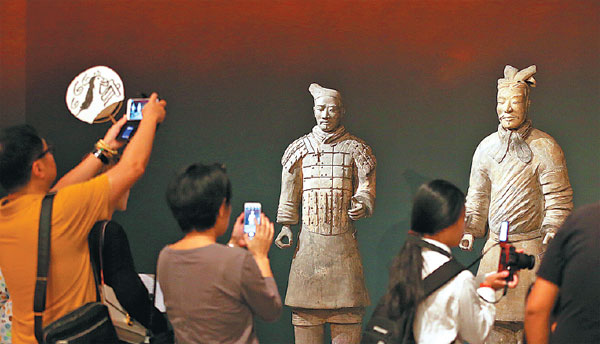 |
The Qin terra cotta warriors. [Photo provided to China Daily] |
Category: English
DepthReading
Key words:
